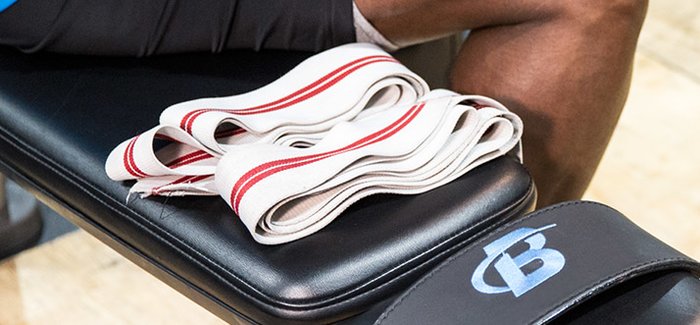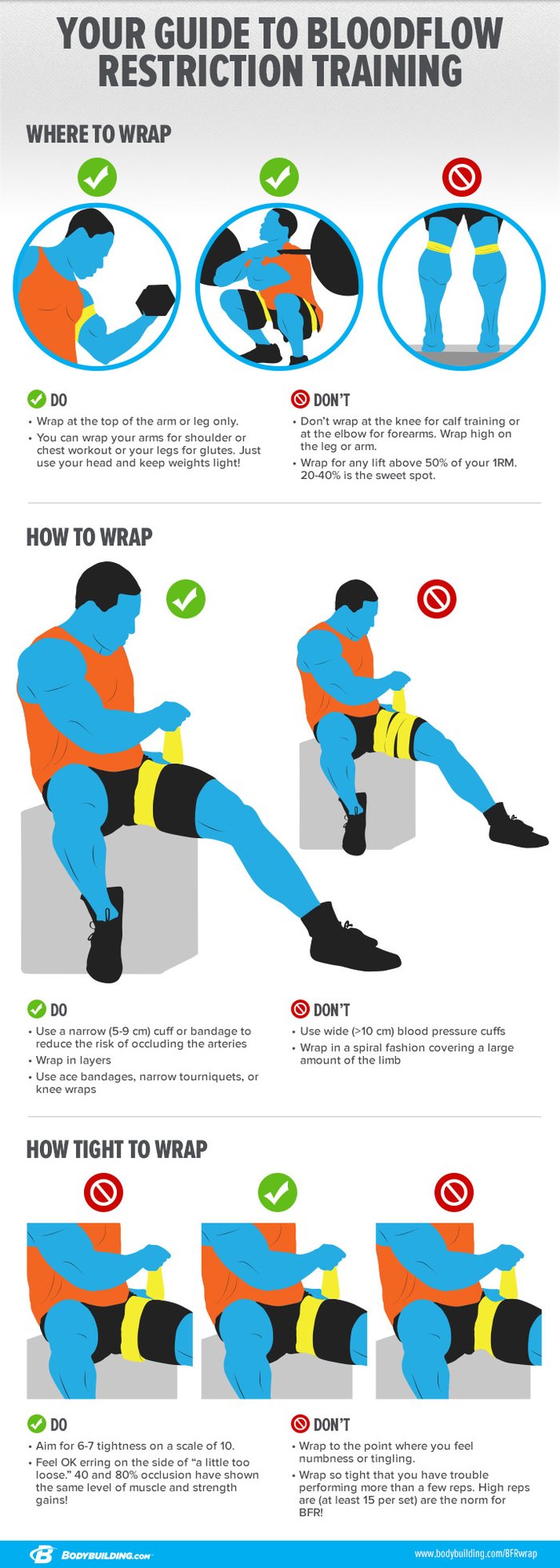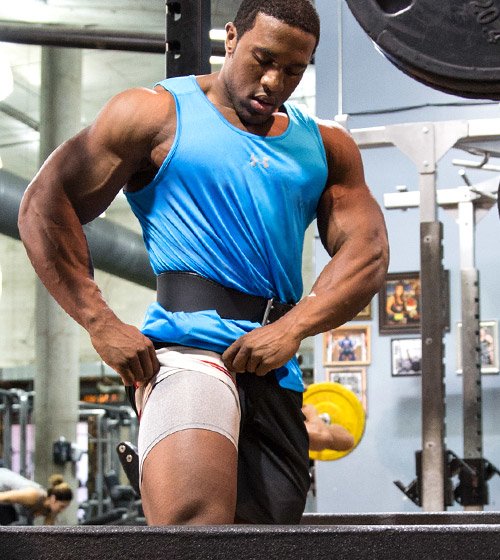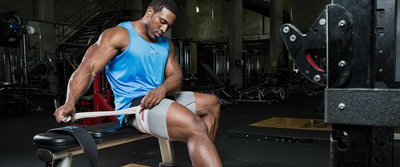Since the first time I wrote about it on this site two years ago, blood flow restriction (BFR) training has become increasingly popular in weight rooms around the world. However, that doesn't mean that it's perfectly understood. In fact, given the many different names (occlusion training, hypoxic training, KAATSU), styles (bands, cuffs, ace bandages), and goals associated with this type of training, the confusion seems to be growing.
After researching BFR for years and studying it firsthand in the lab, I believe it has a lot to offer to a wide range of people who want to gain muscle, increase their training frequency, and try something new in their programming.
Researchers have been digging into the details of BFR for decades, but there's also fascinating new research happening in this area all the time. That's why I'm devoting an entire guide to answering the most common questions I hear about BFR. My goal is for you to have no excuse not to know what's going on in this exciting part of the training world!
I invite you to ask any question you have that didn’t make it into this article, just as I did with my ketogenic dieting article. Just hit me up at @themuscleprof on Instagram, and I’ll respond in a video later this week. Then we’ll post the video here to go along with the article!
What is blood flow restriction and how does it work?
BFR involves wrapping a device such as a pressure cuff, KAATSU device, or even knee wraps around the top portion of a limb to restrict blood flow out of the working muscle. During properly performed BFR, blood is able to enter the muscle via arterial flow; however, the veins are restricted so that blood is partially prevented from leaving the working muscle.

BFR involves wrapping a device such as a pressure cuff, KAATSU device, or even knee wraps around the top portion of a limb to restrict blood flow out of the working muscle.
This arrangement allows for a swelling effect of the muscle, which is the first mechanism of muscle growth I explained in my article, "Mass Class: The Fundamentals of Muscle Growth".[1] Blood flow restriction also causes a buildup of metabolites, such as lactic acid, that have been shown to directly stimulate muscle growth. And the direct fatigue caused to the muscle forces the nervous system to recruit the largest fast-twitch muscle fibers, which have the greatest capacity to grow.[2]

Is a warm-up or cool-down necessary?
In general, BFR is performed at intensities normally used for a warm-up set, such as 30-50 percent of your one-rep max (1RM). As such, I would recommend a light, general warm-up of around five minutes, such as walking or light cycling, followed by 15 unwrapped repetitions with the weight you will use for your first set of BFR.
What should I use to wrap, and how tightly should I wrap?
Traditionally, BFR involves the use of a specialized inflatable cuff, known as a KAATSU device, to restrict venous blood flow. The advantage to such devices is that you can precisely control the pressure and always replicate it on workouts.
Unfortunately, most individuals do not have access to this sophisticated device, which has led our lab to complete extensive research on what is known as practical BFR (pBFR). Practical BFR involves the use of an elastic wrap to restrict blood flow. In studies, we have used knee and elbow wraps. However, cotton elastic bandages can also be used.

While practical, one concern is that you may restrict both the arteries and veins.[3] Arteries bring blood to the muscle, while veins take blood away. To get the maximal swelling response, you want blood coming to the muscle and staying there. Thus, we want to restrict blood flow to the veins without occluding the arteries. This is important to understand because all of the potential negatives resulting from BFR stem from fully occluding both the veins and arteries. In fact, there is evidence that wrapping tight enough to cause arterial occlusion may actually decrease muscle growth at the site wrapped.[4]
To solve this problem, our lab looked at the effects of perceived pressure on blood flow during pBFR. We used knee wraps on the legs and wrapped subjects at a perceived pressure of 0, 7, and 10 out of 10, with 10 being the tightest you could wrap. We found that for the legs, pBFR at a perceived pressure of 7 out of 10 resulted in venous restriction, but not arterial. We also found that when training under this pressure, the subjects experienced drastically increased cell swelling, recruited more muscle, and had a large amount of metabolic stress.
However, it is important to note that at a perceived pressure of 10 out of 10, both venous and arterial blood flow were totally restricted! For more information on this, please see our Project Mass video on BFR.
Where should I wrap, and how wide should I wrap?
Research has shown that a narrower cuff width (5-9 cm) reduces the risk of occluding the arteries, compared to a wider cuff or wrap (13+ cm).[1] For this reason, I also recommend wrapping at the top of the legs or arms in a layered manner rather than wrapping in a spiral manner all the way down the arm or leg.
The size of your arms or legs will also determine how tightly you should wrap. Research shows that smaller limbs have a greater probability of being arterially occluded. For most people, I recommend wrapping at a 7 out of 10 on the legs and a 6 out of 10 on the arms.

How heavy should I lift with BFR?
The primary advantage to BFR is that you can increase muscle size at very low intensities. In fact, some research found that individuals who walked with BFR at low intensities could actually increase muscle size.[5] However, we have found that resistance training results in greater benefits in muscle and strength than walking.[1]
So how heavy should you lift? Research has shown gains with as little as 20 percent of your 1RM. However, muscle growth in this case is primarily caused in the slow-twitch, not fast-twitch, fibers. One study compared moderate-pressure BFR with 20, 30, and 40 percent of subjects' 1RM. They found that fast-twitch muscle fibers were not maximally recruited until 40 percent. However, other research has shown that lifting at 80 percent 1RM compared to 40 percent does not increase muscle fiber recruitment.[6] In addition, there is less metabolic stress.
Taking all this into account, BFR for maximal muscle growth should likely be performed at approximately 40 and no more than 50 percent of 1RM. However, if you are using BFR as a recovery day, then performing resistance training at 20-30 percent of 1RM will likely still result in benefits in the slow-twitch fibers. This could be important, as these fibers are often difficult to hypertrophy.
Is it better to be "just a little too loose" or "just a little too tight?"

Dr. Carlos Ugrinowitsch and his colleagues did a study that addressed just this topic.[7] Ugrinowitsch was one of the first scientists to study the molecular mechanisms of BFR, and I'm fortunate enough to now have this genius working in my lab.
In the study, the researchers put a cuff on subjects and pumped up the pressure so it was either 40 or 80 percent of the pressure necessary to occlude the arteries. From a practical BFR standpoint, it would be like wrapping at a 4 or 8 out of 10. Then they had the subjects perform with either 20 or 40 percent of their 1RM.
Here is the cool thing: Both the 40 and 80 percent occlusion pressures at 40 percent of 1RM produced the same amount of muscle growth and strength gains. The clear takeaway as I see it is that it's better to be a little loose than too tight.
As long as you wrap at a moderate pressure and utilize intensity approaching 40-50 percent 1RM, you should be fine. However, by wrapping too tight, you run the risk of complete arterial occlusion.[3]
Are there any beneficial effects on nonrestricted limb muscles?
Many people think that BFR training is just for the arms and the legs, but can it be used for the chest, back, and glutes? The short answer is yes, there is an increase in muscle activation in the nonrestricted limb muscle.
How can this be? Simply put, by wrapping the arms or legs, the nervous system senses extreme fatigue in the limbs. As such, your body is going to do whatever it can to maintain force and keep itself from failing. To compensate, your nervous system recruits more muscle from nonrestricted limbs.
For example, research published in Clinical Physiology and Functional Imaging found that restricting blood flow to the arms and performing the bench press actually resulted in a 16 percent increase in muscle activation of the pecs.[8] Research has also found that individuals who train their legs with BFR and follow it with an arm workout actually get more growth in the arms than when training them separately.[9]
While the reason for this is unclear, it is possible that growth factors released from BFR and/or circulating metabolites are able to enhance the metabolic effects in the non-BFR arms. Thus, training chest, back, or glutes with the arms or legs restricted may be beneficial for inducing growth in those muscles.
What are the recovery demands of BFR versus other isolation training?
Our lab was the first to study the effects of practical BFR on recovery demands compared to non-BFR low-intensity training.[3] We found that, while BFR caused greater fatigue immediately after the exercise bout, there were no increases in muscle damage or declines in force or power 24 hours later. Pretty impressive!

BFR training requires individuals to train with very high repetitions (15-30 reps). If you are unaccustomed to such high reps, then that by itself may lead to some muscle damage.
Because this type of training has low recovery demands compared to high-intensity training, it is likely that it can be performed up to every other day, but probably not more than this. In fact, we actually found that 2-3 days of BFR per week was best for gains in strength and muscle.[1]
However, BFR training requires individuals to train with very high repetitions (15-30 reps). If you are unaccustomed to such high reps, then that by itself may lead to some muscle damage.[10] However, it is unlikely that the wraps themselves are increasing recovery demands.
Thus, if you are new to BFR and metabolically demanding training, I would recommend using it once to twice a week. Once adapted, you can use it up to three times a week for a lagging body part.
What's better: doing a BFR-only phase for a muscle group, or alternating strength/hypertrophy/BFR days like you recommend in Project Mass?
My student Ryan Lowery and I actually did a study on this question a few years ago using practical BFR.[11] We found that periodizing with BFR for a few weeks followed by high-intensity exercise resulted in a lot of muscle growth.
However, the rate at which you periodize should be dependent on your training status.[12] Based on past periodization research, I would advise that if you are just starting out, it will likely work just as well to alternate every few weeks as it would alternating every day.[13]
However, as your training experience increases, I'd recommend using the Project Mass plan and switching it up every few workouts instead.

Is it necessary or advisable to go to failure with BFR?
BFR taps into a major growth mechanism by recruiting the larger, fast-twitch muscle fibers. Fast-twitch muscle fibers are activated by either heavy resistance or fatigue. Research shows that the closer you get to nearing failure, the greater fast-twitch muscle-fiber recruitment becomes.[14,15] As such, failure under low-intensity conditions is likely a prerequisite to optimal muscle-fiber recruitment when using BFR.

I recommend saving failure for your final set as opposed to every set of BFR. You might begin with 30 repetitions at 40 percent of your 1-RM, rest 30 seconds, hit 15, repeat, and finally go to failure.
However, as I wrote in "Is Training to Failure Helping or Hurting Me?" failure can be very fatiguing to your central nervous system.[16] Thus, I recommend saving failure for your final set as opposed to every set of BFR. You might begin with 30 repetitions at 40 percent of your 1-RM, rest 30 seconds, hit 15, repeat, and finally go to failure.
I'm no bodybuilder, just someone who wants nice, shapely arms. Are 2-3 BFR sessions a week enough for me to see serious results?
Fortunately, a great deal of research has been done in nonbodybuilders.[1] In these populations, we have found that 2-3 workouts with BFR a week is perfect, so the answer is absolutely!
Should I just do a couple of movements, or a whole BFR workout?
While most studies have looked at BFR on its own, our lab has teamed up with Bill Campbell's lab on two studies to investigate the effects of BFR combined with high-intensity resistance training.[2,17]
In both studies, we found that BFR in combination with high-intensity exercise was an effective method for increasing muscle mass. What's interesting is that in the second study, we replaced 60 percent of the high-intensity training with BFR and found that subjects were still able to increase muscle mass just as effectively as 100-percent high-intensity training.
So what does this mean to you? First, BFR can increase muscle growth, either as a standalone practice or in combination with heavy training. Second, because BFR causes very little muscle damage, it can be used during deloading periods to supplement as much as 60 percent of the high-intensity workload. This will give athletes the ability to progress while allowing their joints and/or injuries to heal.
I normally recommend using BFR as either a light recovery day on its own, as a method to deload and heal, or as a method to finish the muscle at the end of a workout. The finisher method is supported by studies showing that a heavy workout that incorporates a very high repetition set at the end performed at 50 percent of your 1RM can increase hypertrophy and strength compared to high-intensity exercise alone.[18]
To use BFR as a finisher, do an isolation movement such as curls or leg extensions for 4 sets of 30, 15, 15, 15 reps, with 30 seconds of rest between sets, using 20-40 percent of your one-rep max. Perform this 1-3 times per week.
Is BFR safe for my cardiovascular system?
Prior to beginning any exercise program, it's important to have clearance from your physician. As such, all of the recommendations I discuss in this paper are for healthy individuals, free of disease, who already safely incorporate high-intensity resistance exercise into their weekly routine. While the safety and potential benefits of BFR in clinical populations are actively being studied, that discussion is beyond the scope of this article. However, I can address how BFR compares to traditional resistance training for the cardiovascular and nervous systems.

It has been proposed that restricting blood flow causes damage to veins and ultimately impairs long-term blood flow. However, research shows that, while blood flow is restricted during exercise, over time (four weeks) there is an actual increase in the ability to vasodilate and increase blood flow, compared to traditional resistance training alone.[19]
Moreover, with heavy resistance training (80-100 percent 1RM), mean arterial blood pressure has been shown to more than double, with heart rates reaching maximal levels.[20-21] However, research on low-intensity BFR shows an increase in blood pressure and heart rate by only 11-13 percent.[22] As such, traditional resistance exercise results in much greater blood pressure, heart rate, and even cardiac-output changes than low-intensity BFR.
Why the drastic differences? You should understand that, when doing BFR with low-intensity exercise, studies have applied pressures around the limb ranging from 50-230 mmHg.[23] However, during maximal high-intensity exercise, muscles contract so hard that intramuscular pressures average around 500 mmHg, and have been recorded as high as over 1000 mmHg![24,25]
By comparison, general complete arterial restriction occurs at a range of 140-235 mmHg of an externally applied pressure.[23] Moreover, complete blockage of blood flow has been shown to occur with traditional resistance exercise with as low as 50 and 64 percent of an individual's 1RM.
It's important to realize that traditional resistance exercise already results in occlusion of blood vessels during even moderate-force contractions. Therefore, BFR is only mimicking this response at lower intensity levels.
What about blood clots?
Another concern with BFR is that it may cause thrombosis. Thrombosis is the formation of a blood clot inside a blood vessel, which obstructs blood flow. The three major factors thought to cause this are a hyperability to form a blood clot (hypercoagulability), vascular damage, and vascular occlusion of blood flow.
It's important to know that the formation of a clot is caused by the imbalance between coagulation and fibrinolytic (the breakdown of coagulation products) processes. Research with low-intensity BFR has shown that this type of activity does not increase coagulation. In fact, it may actually increase the breakdown of clots (e.g., increase fibrinolytic activity).[22,26,27] So based on what we know now, it appears to be perfectly safe.
Nevertheless, it is definitely important when using BFR that you restrict but do not completely occlude arterial flow. Remember what I said earlier: 40 percent occlusion has been shown to have the same level of benefit as 80 percent, so there's no downside to erring on the side of caution.
Is BFR safe for my nervous system?
This is a common question. In a survey published in Metabolism, a small percentage of BFR training sessions led to numbness in the wrapped limb.[28] This leads to the implication that BFR could be too taxing on the nervous system; however, further studies looking at nerve conduction velocity (speed at which a nerve impulse is transmitted) saw no change following four weeks of BFR at 30 percent of 1RM.[26]
To me, this indicates that several of the BFR training sessions that led to numbness could have been a result of improper wrapping techniques. Learn to do it right, and you should have nothing to fear.
Want to give BFR a go in your workouts, AND have a full plan to follow for muscle and strength gains? Swole and Strong by Mike Hildebrandt incorporates this method of training on top of your classic push, pull, and lower body split for getting all the results you want from consistent training. Follow now on BodyFit now!
References
- Loenneke JP, Abe T, Wilson JM, Ugrinowitsch C, & Bemben MG (2012) Blood flow restriction: how does it work? Frontiers in Physiology, 3, 392.
- Loenneke JP, Wilson GJ, & Wilson JM (2010) A mechanistic approach to blood flow occlusion. International Journal of Sports Medicine, 31(1), 1-4.
- Wilson, J. M., Lowery, R. P., Joy, J. M., Loenneke, J. P., & Naimo, M. A. (2013). Practical blood flow restriction training increases acute determinants of hypertrophy without increasing indices of muscle damage. The Journal of Strength & Conditioning Research, 27(11), 3068-3075.
- Kacin, A., & Strazar, K. (2011). Frequent low-load ischemic resistance exercise to failure enhances muscle oxygen delivery and endurance capacity. Scandinavian Journal of Medicine & Science in Sports, 21(6), e231-e241.
- Fry, C. S., Glynn, E. L., Drummond, M. J., Timmerman, K. L., Fujita, S., Abe, T., ... & Rasmussen, B. B. (2010). Blood flow restriction exercise stimulates mTORC1 signaling and muscle protein synthesis in older men. Journal of Applied Physiology, 108(5), 1199-1209.
- Takarada, Y., Takazawa, H., Sato, Y., Takebayashi, S., Tanaka, Y., & Ishii, N. (2000). Effects of resistance exercise combined with moderate vascular occlusion on muscular function in humans. Journal of Applied Physiology, 88(6), 2097-2106.
- Lixandrão, M. E., Ugrinowitsch, C., Laurentino, G., Libardi, C. A., Aihara, A. Y., Cardoso, F. N., ... & Roschel, H. (2015). Effects of exercise intensity and occlusion pressure after 12 weeks of resistance training with blood-flow restriction. European Journal of Applied Physiology, 1-10.
- Yasuda, T., Fujita, S., Ogasawara, R., Sato, Y., & Abe, T. (2010). Effects of low-intensity bench press training with restricted arm muscle blood flow on chest muscle hypertrophy: a pilot study. Clinical Physiology and Functional Imaging, 30(5), 338-343.
- Madarame, H., Neya, M., Ochi, E., Nakazato, K., Sato, Y., & Ishii, N. (2008). Cross-transfer effects of resistance training with blood flow restriction. Medicine and Science in Sports and Exercise, 40(2), 258.
- Wernbom, M., Paulsen, G., Nilsen, T. S., Hisdal, J., & Raastad, T. (2012). Contractile function and sarcolemmal permeability after acute low-load resistance exercise with blood flow restriction. European Journal of Applied Physiology, 112(6), 2051-2063.
- Lowery, R. P., Joy, J. M., Loenneke, J. P., Souza, E. O., Machado, M., Dudeck, J. E., & Wilson, J. M. (2014). Practical blood flow restriction training increases muscle hypertrophy during a periodized resistance training programme. Clinical Physiology and Functional Imaging, 34(4), 317-321.
- Monteiro, A. G., Aoki, M. S., Evangelista, A. L., Alveno, D. A., Monteiro, G. A., da Cruz Picarro, I., & Ugrinowitsch, C. (2009). Nonlinear periodization maximizes strength gains in split resistance training routines. The Journal of Strength & Conditioning Research, 23(4), 1321-1326.
- Buford, T. W., Rossi, S. J., Smith, D. B., & Warren, A. J. (2007). A comparison of periodization models during nine weeks with equated volume and intensity for strength. The Journal of Strength & Conditioning Research, 21(4), 1245-1250.
- Fallentin, N., Jørgensen, K., & Simonsen, E. B. (1993). Motor unit recruitment during prolonged isometric contractions. European Journal of Applied Physiology and Occupational Physiology, 67(4), 335-341.
- Garland, S. J., Enoka, R. M., Serrano, L. P., & Robinson, G. A. (1994). Behavior of motor units in human biceps brachii during a submaximal fatiguing contraction. Journal of Applied Physiology, 76(6), 2411-2419.
- Ahtiainen, J. P., Pakarinen, A., Kraemer, W. J., & Häkkinen, K. (2003). Acute hormonal and neuromuscular responses and recovery to forced vs maximum repetitions multiple resistance exercises. International Journal of Sports Medicine, 24(6), 410-418.
- O'Halloran, J., Campbell, B., Martinez, N., O'Connor, S., Fuentes, J., Theilen, N., ... & Kilpatrick, M. (2014). The effects of practical vascular blood flow restriction training on skeletal muscle hypertrophy. Journal of the International Society of Sports Nutrition, 11(Suppl 1), P18.
- Goto, K., Nagasawa, M., Yanagisawa, O., Kizuka, T., ISHII, N., & Takamatsu, K. (2004). Muscular adaptations to combinations of high-and low-intensity resistance exercises. The Journal of Strength & Conditioning Research, 18(4), 730-737.
- Patterson, S. D., & Ferguson, R. A. (2010). Increase in calf post-occlusive blood flow and strength following short-term resistance exercise training with blood flow restriction in young women. European Journal of Applied Physiology, 108(5), 1025-1033.
- MacDougall, J. D., Tuxen, D. S. D. G., Sale, D. G., Moroz, J. R., & Sutton, J. R. (1985). Arterial blood pressure response to heavy resistance exercise. Journal of Applied Physiology, 58(3), 785-790.
- MacDougall, J. D., McKelvie, R. S., Moroz, D. E., Sale, D. G., McCartney, N., & Buick, F. (1992). Factors affecting blood pressure during heavy weight lifting and static contractions. Journal of Applied Physiology, 73(4), 1590-1597.
- Takano, H., Morita, T., Iida, H., Asada, K. I., Kato, M., Uno, K., ... & Nakajima, T. (2005). Hemodynamic and hormonal responses to a short-term low-intensity resistance exercise with the reduction of muscle blood flow. European Journal of Applied Physiology, 95(1), 65-73.
- Loenneke, J. P., Wilson, J. M., Marín, P. J., Zourdos, M. C., & Bemben, M. G. (2012). Low intensity blood flow restriction training: a meta-analysis. European Journal of Applied Physiology, 112(5), 1849-1859.
- Sylvest, O., & Hvid, N. (1959). Pressure measurements in human striated muscles during contraction. Acta Rheumatologica Scandinavica, 5(1-4), 216-222.
- Sylvest, O., & Hvid, N. (1959). Pressure measurements in human striated muscles during contraction. Acta Rheumatologica Scandinavica, 5(1-4), 216-222.
- Clark, B. C., Manini, T. M., Hoffman, R. L., Williams, P. S., Guiler, M. K., Knutson, M. J., ... & Kushnick, M. R. (2011). Relative safety of 4 weeks of blood flow-restricted resistance exercise in young, healthy adults. Scandinavian Journal of Medicine & Science in Sports, 21(5), 653-662.
- Fry, C. S., Glynn, E. L., Drummond, M. J., Timmerman, K. L., Fujita, S., Abe, T., ... & Rasmussen, B. B. (2010). Blood flow restriction exercise stimulates mTORC1 signaling and muscle protein synthesis in older men. Journal of Applied Physiology, 108(5), 1199-1209.
- Yasuda, T., Abe, T., Brechue, W. F., Iida, H., Takano, H., Meguro, K., ... & Nakajima, T. (2010). Venous blood gas and metabolite response to low-intensity muscle contractions with external limb compression. Metabolism, 59(10), 1510-1519.

